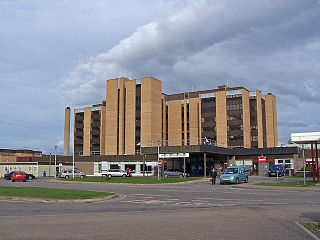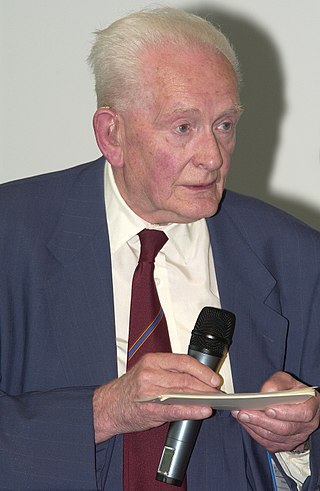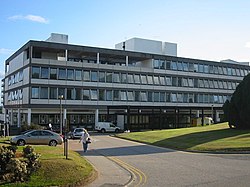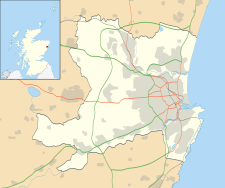
Raigmore Hospital is a health facility located in Inverness, Scotland. It serves patients from the local area as well as providing specialist services to patients from across the Highland area. It is a teaching hospital, educating a range of healthcare professionals in association with the Universities of Aberdeen and Stirling. It is managed by NHS Highland.

Manchester Royal Infirmary (MRI) is a large NHS teaching hospital in Chorlton-on-Medlock, Manchester, England. Founded by Charles White in 1752 as part of the voluntary hospital movement of the 18th century, it is now a major regional and national medical centre. It is the largest hospital within Manchester University NHS Foundation Trust, and based on its Oxford Road Campus in South Manchester where it shares a site with the Royal Manchester Children's Hospital, Manchester Royal Eye Hospital and Saint Mary's Hospital as well as several other educational and research facilities. The Hospital is also a key site for medical educational within Manchester, serving as a main teaching hospital for School of Medical Sciences, University of Manchester.

The James Cook University Hospital is a tertiary referral hospital and regional major trauma centre in Middlesbrough, North Yorkshire, England located on the A172. Having 1,046 beds, it caters for most specialities and forms part of the South Tees Hospitals NHS Foundation Trust, along with the Friarage Hospital in Northallerton.
Foresterhill is an area of Aberdeen, Scotland. It is the site of the city's main hospitals, as well as the medical school and medical science departments of the University of Aberdeen. It is the largest hospital complex in Europe.

The Royal Infirmary of Edinburgh (RIE), often known as the Edinburgh Royal Infirmary (ERI), was established in 1729 and is the oldest voluntary hospital in Scotland. The new buildings of 1879 were claimed to be the largest voluntary hospital in the United Kingdom, and later on, the Empire. The hospital moved to a new 900 bed site in 2003 in Little France. It is the site of clinical medicine teaching as well as a teaching hospital for the University of Edinburgh Medical School. In 1960, the first successful kidney transplant performed in the UK was at this hospital. In 1964, the world's first coronary care unit was established at the hospital. It is the only site for liver, pancreas and pancreatic islet cell transplantation and one of two sites for kidney transplantation in Scotland. In 2012, the Emergency Department had 113,000 patient attendances, the highest number in Scotland. It is managed by NHS Lothian.

NHS Grampian is an NHS board which forms one of the fourteen regional health boards of NHS Scotland. It is responsible for proving health and social care services to a population of over 500,000 people living in Aberdeen, Aberdeenshire and Moray.

The Royal Aberdeen Children's Hospital or RACH is a children's hospital in Aberdeen, Scotland. It is situated on the Foresterhill site, with the Aberdeen Royal Infirmary and Aberdeen Maternity Hospital and provides services to children across the North of Scotland. It is managed by NHS Grampian.

Woodend Hospital is a health facility located in the Woodend area of Aberdeen, Scotland. It is managed by NHS Grampian.

Woolmanhill Hospital was a health facility in the city centre of Aberdeen, Scotland. It was the original Aberdeen Royal Infirmary, a complex which opened in 1749 and was replaced by new facility at Foresterhill in 1936. After services transferred to Aberdeen Community Health and Care Village, the Foresterhill site and Woodend Hospital, the Woolmanhill Hospital closed in April 2017. The complex is centred on a neo-classical main block with later nineteenth century buildings to the rear. Unusually, it has remained largely complete, with later building having taken place at Foresterhill. It was managed by NHS Grampian.

The Royal United Hospital (RUH) is a major acute-care hospital in the Weston suburb of Bath, England, which lies approximately 1.5 miles (2.4 km) west of the city centre. The hospital has 565 beds and occupies a 52 acres (21 ha) site. It is the area's major accident and emergency hospital, with a helicopter landing point on the adjacent Lansdown Cricket Club field. The hospital is operated by the Royal United Hospitals Bath NHS Foundation Trust.
Kincardine Community Hospital is a small hospital at Kirkton Road, Stonehaven, Aberdeenshire, Scotland. It is managed by NHS Grampian.

Ninewells Hospital is a large teaching hospital, based on the western edge of Dundee, Scotland. It is internationally renowned for introducing laparoscopic surgery to the UK as well as being a leading centre in developing fields such as the management of cancer, medical genetics and robotic surgery. Within the UK, it is also a major NHS facility for psychosurgery. The medical school was ranked first in the UK in 2009. The hospital has nursing and research links with the University of Dundee and is managed by NHS Tayside.

Hull Royal Infirmary is a tertiary teaching hospital and is one of the two main hospitals for Kingston upon Hull. It is situated on Anlaby Road, just outside the city centre, and is run by Hull University Teaching Hospitals NHS Trust.

John Rowland Mallard OBE FRSE FREng was an English physicist and professor of Medical Physics at the University of Aberdeen from 1965 until his retirement in 1992. He was known for setting up and leading the team that developed the first magnetic resonance imaging (MRI) full body scanner and, in particular, positron emission tomography (PET). He was born in Kingsthorpe, Northampton, England.

Roxburghe House is a specialist palliative care unit which is situated near Foresterhill, Aberdeen, Scotland. It is managed by NHS Grampian.

Bristol Royal Hospital for Children, also known as the Bristol Children's Hospital, is a paediatric hospital in Bristol and the only paediatric major trauma centre in South West England. The hospital is part of the University Hospitals Bristol and Weston NHS Foundation Trust (UHBW), which includes eight other hospitals. The hospital is located next to the Bristol Royal Infirmary in the city centre.

The Suttie Centre is a purpose-built training centre on the Foresterhill hospital campus in Aberdeen.
Scottish Specialist Transport and Retrieval (ScotSTAR) is the Scottish national service for adult, paediatric and neonatal patients. The service is run by the Scottish Ambulance Service and brings together NHS Scotland's three specialist transport and retrieval services: the Scottish Neonatal Transport Service (SNTS), the Transport of Critically Ill and Injured Children Service and the Emergency Medical Retrieval Service (EMRS). The service operates from a bespoke base near Glasgow and expects to be able to cater for 2,200 critically ill children and adults every year.

The Northumbria Specialist Emergency Care Hospital is a hospital specialising in emergency care for sick and injured patients, opened in 2015 in Cramlington, Northumberland, England by the Northumbria Healthcare NHS Foundation Trust.
A major trauma centre (MTC) is a specialist unit within the National Health Service of the United Kingdom, set up to provide specialised trauma care and rehabilitation. They are usually found within larger hospitals in major cities which have the necessary infrastructure and staff to deal with major trauma cases.


















